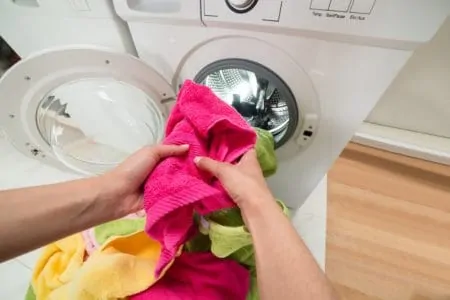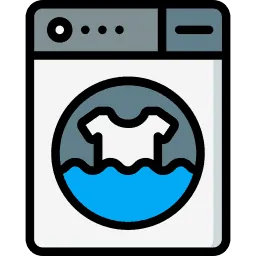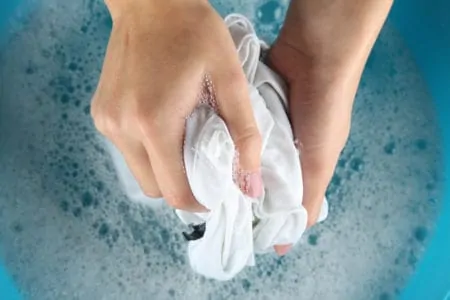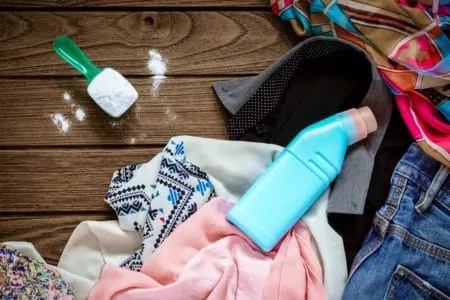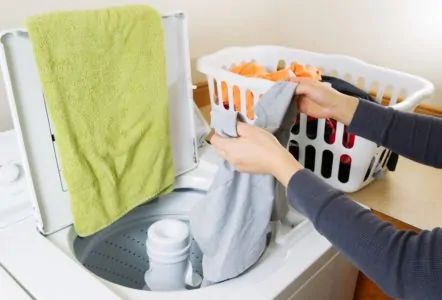When you wash your towels correctly, they’ll last longer. Using the correct washing techniques helps them stay soft, fluffy and fresh.
We’ll show you how to wash towels, how to dry them, and how often to go through this routine. With these amazing tips, your towels — no matter the color and texture — will look and feel as good as new!
Key Takeaways
- Wash towels every three uses and air dry between washes to prevent germs and odors.
- For machine washing, use half the usual detergent and one cup of white vinegar; skip fabric conditioner.
- Hand-wash towels by soaking them in detergent and water, then scrubbing and rinsing to remove dirt and soap.
- Air dry or machine dry towels, but avoid using fabric softener or dryer sheets to maintain absorbency.
How Often Should You Wash Towels?
We recommend washing your towels every three uses. Between washes, after every shower, let the towel air dry completely to prevent germs from harboring.
Washcloths should be washed after every use. These washcloths are exposed to more dead skin cells, and they get much more wet than towels (1).
Gym towels should be washed after every use since they are exposed to more sweat.
Kitchen towels that have been exposed to food, such as raw chicken breasts, should be washed after every use.
Finally, if your towel has been exposed to bodily fluids, or you have eczema, you should wash the towel after every use. If you have eczema, this protects your skin from further irritation. Likewise, if you are sick or carrying an infection, wash your towels after every use.
Bonus Tip
How to Wash Towels by Hand
Hand-washing towels saves money and energy. Plus, it’s kinder on the towels so they won’t wear down as quickly. While it does require a bit more effort, the pros outweigh the cons for many families. Of course, it’ll definitely come in handy if your machine is ever to break!
What You Need
- Dirty towels.
- Sink, tub or basin.
- Soap.
- Cloth.
- Detergent.
- Borax (optional).
- Rubber gloves.
- Bleach (if disinfecting).
We do recommend a mild detergent, but any laundry detergent will do the job. If you’re dumping the water outside afterwards, it would help to use an eco-friendly detergent as that’s kinder on the environment.
Instructions
- Clean your tub, sink or basin with soap and warm water. Use your cloth to scrub it clean.
- Fill the tub with cold or warm water. You don’t need to use super hot water.
- Add your detergent. For a basin or sink, we recommend about one tablespoon of detergent. For a bathtub, use four tablespoons. Remember, less is sometimes more. Too much detergent can leave a residue on your fabrics. If you are using bleach, follow the manufacturer’s instructions for the recommended measurement regarding your amount of water.
- Mix together thoroughly wearing rubber gloves.
- If you have hard water, add one tablespoon of Borax per gallon of water. This softens your water and empowers your detergent to do a better job. It’s safe to mix bleach and Borax, so you can still use it if you’re using bleach.
- Add your towels and let them soak for up to an hour depending on how soiled they are.
- Rub the towels together to loosen dirt. Scrub together until clean. You can press them against the side of the tub to remove excess dirt. Do this for each towel.
- Drain the water. Rinse each towel under the tap to remove excess dirt and soap.
- As an extra step, you can fill the tub back up with cold water and let the towels soak again for five minutes. This ensures that all dirt and soap is gone.
- Drain any leftover water. Remove excess water from each towel by pressing it against the side of the tub or squeezing the towel. We don’t recommend twist wringing any fabric, as it can stretch the towels. If you have a hand wringer, that’s an awesome tool to use!
How to Wash Towels in the Washing Machine
Washing towels in the machine is easy, effective and saves you time.
What You Need
- Laundry detergent.
- White vinegar.
- Baking soda (optional).
Instructions
Before we get into the steps, we recommend washing towels separately from other clothes. Towels are absorbent so they can pick up lint and dirt from other fabrics. Lastly, we also recommend separating your towels by color. If you wash white and red towels together, well, we all know what will happen: pink towels!
- Read the towel’s care label to check the recommended temperature. Most towels can be washed in hot water, but darks and colored towels often require warm water. Microfiber towels require cool or warm water.
- Add half the usual amount of your laundry detergent. Too much detergent can build up on fabrics and make towels less fluffy and absorbent. If you have luxury or super soft towels, use a mild or eco detergent.
- Skip the fabric conditioner. Fabric conditioner and dryer sheets can build up on towels. They become less absorbent. Instead, add one cup of distilled white vinegar to the drum or detergent tray. White vinegar can also kill odors and mold (2).
- Set it to the cycle that matches the material of your towels. For example, put cotton towels on a cotton cycle. Choose the correct temperature.
- For extra cleanliness, try this next step. You can skip it if you don’t have the time. After the cycle is finished, add ½ cup of baking soda to the drum or detergent dispenser and run a short cycle. Baking soda can soften fabrics and reduce odors (3).
Warning
How to Dry Towels
Air Drying
Shake towels after removing them from the machine. This encourages softness and fluffiness. Hang them up immediately to reduce their chances of harboring mold and bacteria.
We recommend hanging them outside on a dry, sunny day. If it’s too humid, they can take too long to dry. In that case, hang them up inside in a warm room. Make sure there’s decent air flow to speed up drying times.
Air dry until completely dry or toss them in the dryer for half an hour towards the end. This can fluff them up, leaving them nice and soft.
Machine Drying
Before putting towels in the machine, give them a good shake to fluff them up. Then follow these steps:
- Clean out the lint trap on your tumble dryer. This prevents fires, but also ensures that no excess lint becomes attached to towels.
- Skip the dryer sheets! These can coat your towels and cause them to lose their absorbency. Instead, add wool dryer balls or even a tennis ball to encourage softness and reduce static.
- Read the care label. Check the material, and dry according to that material.
- Set the cycle to half an hour shorter than the recommended time so that you take the towels out when they’re still slightly damp. Air drying them the rest of the way. This encourages softness so your towels resemble hotel or spa fluffiness!
Overall, a combination of air drying and tumble drying is the best way to have soft, fluffy, lush towels.
FAQs
Don’t Throw in the Towel
Don’t give up on your towels. Even if they’re looking a little dingy and worn out, you can revive them. But the best thing to do is to keep them in a good condition from the get-go.
Our tips for handwashing, machine washing and drying will leave you with hotel quality, soft, clean and fluffy towels.
